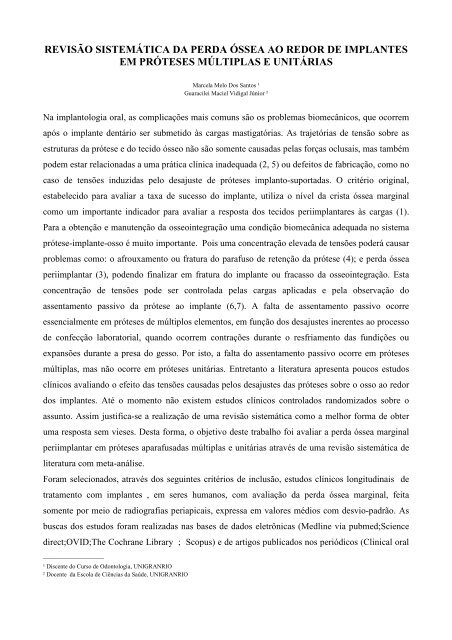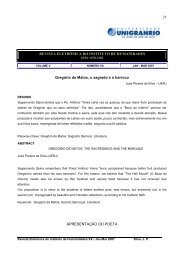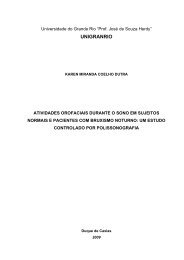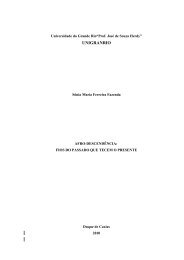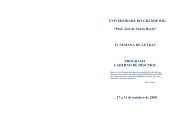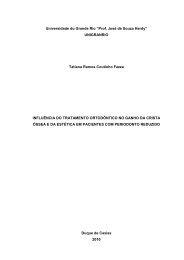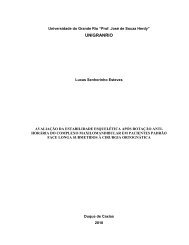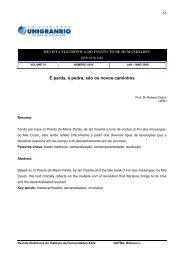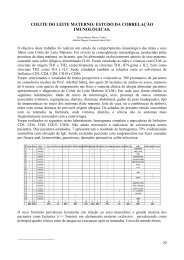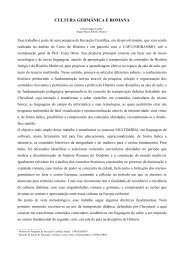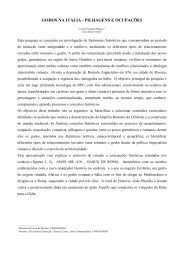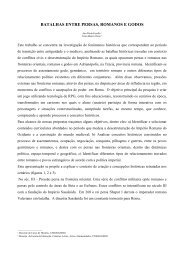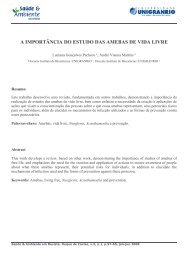revisão sistemática da perda óssea ao redor de ... - Unigranrio
revisão sistemática da perda óssea ao redor de ... - Unigranrio
revisão sistemática da perda óssea ao redor de ... - Unigranrio
You also want an ePaper? Increase the reach of your titles
YUMPU automatically turns print PDFs into web optimized ePapers that Google loves.
REVISÃO SISTEMÁTICA DA PERDA ÓSSEA AO REDOR DE IMPLANTES<br />
EM PRÓTESES MÚLTIPLAS E UNITÁRIAS<br />
Marcela Melo Dos Santos ¹<br />
Guaracilei Maciel Vidigal Júnior ²<br />
Na implantologia oral, as complicações mais comuns são os problemas biomecânicos, que ocorrem<br />
após o implante <strong>de</strong>ntário ser submetido às cargas mastigatórias. As trajetórias <strong>de</strong> tensão sobre as<br />
estruturas <strong>da</strong> prótese e do tecido ósseo não são somente causa<strong>da</strong>s pelas forças oclusais, mas também<br />
po<strong>de</strong>m estar relaciona<strong>da</strong>s a uma prática clínica ina<strong>de</strong>qua<strong>da</strong> (2, 5) ou <strong>de</strong>feitos <strong>de</strong> fabricação, como no<br />
caso <strong>de</strong> tensões induzi<strong>da</strong>s pelo <strong>de</strong>sajuste <strong>de</strong> próteses implanto-suporta<strong>da</strong>s. O critério original,<br />
estabelecido para avaliar a taxa <strong>de</strong> sucesso do implante, utiliza o nível <strong>da</strong> crista <strong>óssea</strong> marginal<br />
como um importante indicador para avaliar a resposta dos tecidos periimplantares às cargas (1).<br />
Para a obtenção e manutenção <strong>da</strong> osseointegração uma condição biomecânica a<strong>de</strong>qua<strong>da</strong> no sistema<br />
prótese-implante-osso é muito importante. Pois uma concentração eleva<strong>da</strong> <strong>de</strong> tensões po<strong>de</strong>rá causar<br />
problemas como: o afrouxamento ou fratura do parafuso <strong>de</strong> retenção <strong>da</strong> prótese (4); e per<strong>da</strong> <strong>óssea</strong><br />
periimplantar (3), po<strong>de</strong>ndo finalizar em fratura do implante ou fracasso <strong>da</strong> osseointegração. Esta<br />
concentração <strong>de</strong> tensões po<strong>de</strong> ser controla<strong>da</strong> pelas cargas aplica<strong>da</strong>s e pela observação do<br />
assentamento passivo <strong>da</strong> prótese <strong>ao</strong> implante (6,7). A falta <strong>de</strong> assentamento passivo ocorre<br />
essencialmente em próteses <strong>de</strong> múltiplos elementos, em função dos <strong>de</strong>sajustes inerentes <strong>ao</strong> processo<br />
<strong>de</strong> confecção laboratorial, quando ocorrem contrações durante o resfriamento <strong>da</strong>s fundições ou<br />
expansões durante a presa do gesso. Por isto, a falta do assentamento passivo ocorre em próteses<br />
múltiplas, mas não ocorre em próteses unitárias. Entretanto a literatura apresenta poucos estudos<br />
clínicos avaliando o efeito <strong>da</strong>s tensões causa<strong>da</strong>s pelos <strong>de</strong>sajustes <strong>da</strong>s próteses sobre o osso <strong>ao</strong> <strong>redor</strong><br />
dos implantes. Até o momento não existem estudos clínicos controlados randomizados sobre o<br />
assunto. Assim justifica-se a realização <strong>de</strong> uma <strong>revisão</strong> <strong>sistemática</strong> como a melhor forma <strong>de</strong> obter<br />
uma resposta sem vieses. Desta forma, o objetivo <strong>de</strong>ste trabalho foi avaliar a per<strong>da</strong> <strong>óssea</strong> marginal<br />
periimplantar em próteses aparafusa<strong>da</strong>s múltiplas e unitárias através <strong>de</strong> uma <strong>revisão</strong> <strong>sistemática</strong> <strong>de</strong><br />
literatura com meta-análise.<br />
Foram selecionados, através dos seguintes critérios <strong>de</strong> inclusão, estudos clínicos longitudinais <strong>de</strong><br />
tratamento com implantes , em seres humanos, com avaliação <strong>da</strong> per<strong>da</strong> <strong>óssea</strong> marginal, feita<br />
somente por meio <strong>de</strong> radiografias periapicais, expressa em valores médios com <strong>de</strong>svio-padrão. As<br />
buscas dos estudos foram realiza<strong>da</strong>s nas bases <strong>de</strong> <strong>da</strong>dos eletrônicas (Medline via pubmed;Science<br />
direct;OVID;The Cochrane Library ; Scopus) e <strong>de</strong> artigos publicados nos periódicos (Clinical oral<br />
____________________<br />
¹ Discente do Curso <strong>de</strong> Odontologia, UNIGRANRIO<br />
² Docente <strong>da</strong> Escola <strong>de</strong> Ciências <strong>da</strong> Saú<strong>de</strong>, UNIGRANRIO
implants research;The International Journal Periodontics & Restorative Dentistry;The International<br />
Journal of Prosthodontics;The International Journa of Oral & Maxillofacial implants ), usando as<br />
seguintes palavras-chave: per<strong>da</strong> <strong>óssea</strong> (bone loss),implantes (implants) e próteses (prosthesis). Para<br />
a seleção dos estudos foram utilizados critérios <strong>de</strong> exclusão. Os critérios <strong>de</strong> exclusão aplicados<br />
foram: relatos <strong>de</strong> caso; radiografias panorâmicas, ausência dos valores <strong>de</strong> média e <strong>de</strong>svio-padrão<br />
dos resultados; estudos com implantes tipo "plataforma shift"; carga imediata; estudos in vitro e em<br />
animais; artigos que não forem em língua inglesa; estudos com acompanhamento inferior a um ano;<br />
artigos com estudos com próteses removíveis; e estudos on<strong>de</strong> foram realizados enxertos ósseos.<br />
Estas fases foram realiza<strong>da</strong>s por dois pesquisadores e, em caso <strong>de</strong> dúvi<strong>da</strong>s, um terceiro pesquisador<br />
<strong>de</strong>terminou a inclusão/exclusão do estudo.<br />
Os artigos selecionados foram submetidos à fase <strong>de</strong> extração <strong>de</strong> <strong>da</strong>dos, on<strong>de</strong> foram analisa<strong>da</strong>s as<br />
variáveis, as características <strong>da</strong> metodologia e os <strong>de</strong>sfechos clínicos. Nesta fase foram extraídos os<br />
seguintes <strong>da</strong>dos: número <strong>de</strong> pacientes envolvidos no estudo; projeto do implante; número <strong>de</strong><br />
implantes; sistema <strong>de</strong> implante (marca comercial); tipo <strong>de</strong> prótese sobre implante (unitária ou<br />
múltipla); período <strong>de</strong> acompanhamento; número <strong>de</strong> passos cirúrgicos (um ou dois); região (maxila<br />
ou mandíbula); conexão protética; sistema <strong>de</strong> retenção; taxa <strong>de</strong> sucesso dos implantes; per<strong>da</strong> <strong>óssea</strong><br />
em milímetros expressa em valores médios e <strong>de</strong>svio-padrão.<br />
Após a busca eletrônica e a busca manual nos periódicos selecionados (tabela 1), usando as<br />
palavras-chave, 364 títulos foram selecionados. Após a análise dos títulos, 101 trabalhos foram<br />
excluídos por não se enquadrarem nos critérios <strong>de</strong> inclusão ou por serem duplicatas (tabela 2; tabela<br />
3). Em segui<strong>da</strong>, aplicando os mesmos critérios <strong>de</strong> inclusão/exclusão <strong>ao</strong>s 263 resumos dos trabalhos<br />
restantes, foram selecionados 19 trabalhos para fase <strong>de</strong> extração <strong>de</strong> <strong>da</strong>dos (tabela 4; tabela 5 ; tabela<br />
6).<br />
Tabela 1-Referente <strong>ao</strong>s resultados <strong>de</strong> busca manual e busca eletrônica<br />
Medline (via Pubmed) 113<br />
Science Direct 47<br />
Scopus 37<br />
OVID 23<br />
Cochrane Library 57<br />
Manual 39<br />
TOTAL ENCONTRADOS
Tabela 2 – Referente <strong>ao</strong>s critérios <strong>de</strong> exclusão<br />
Tabela 3 - Critérios <strong>de</strong> exclusão<br />
Critérios <strong>de</strong> exclusão<br />
Tabela 4-Envolvendo próteses unitárias<br />
Sem avaliação radiográfica 64<br />
Radiografia panorâmica 17<br />
Sem Desvio padrão 46<br />
Total <strong>de</strong> artigos excluídos 127<br />
Número <strong>de</strong> artigos excluídos<br />
Critérios <strong>de</strong> exclusão Número <strong>de</strong> artigos avaliados<br />
Relato <strong>de</strong> caso 19<br />
Estudo em animais 08<br />
Estudo em cadáveres 02<br />
Estudo In vitro 59<br />
Implante Imediato 08<br />
Carga Imediata 52<br />
Enxerto ósseo 16<br />
Prótese múltipla cimenta<strong>da</strong> 15<br />
Plataforma Switch 07<br />
Doença Sistêmica 03<br />
Prótese removível 26<br />
Acompanhamento inferior a 1 ano 02<br />
Total <strong>de</strong> artigos excluídos 217<br />
Hall JAG et Henriksson K & Jemt T, Vigolo P et Glauser R Drago CJ, Vigolo &<br />
al., 2006 Jemt T, 2003 2008 al., 2006 et al., 2004 2003 Zaccaria, 2010<br />
Nº <strong>de</strong> pacientes 14 20 27 20 19 69 44<br />
Nº <strong>de</strong> implantes 14 24 32 40 36 104 60<br />
Sistema/fabricante<br />
Southern<br />
Implants<br />
MK III – Nobel<br />
Biocare<br />
Brånemark<br />
System –<br />
Nobel<br />
Biocare<br />
Osseotite -<br />
3i<br />
MK II –<br />
Nobel<br />
Biocare<br />
Osseotite –<br />
3i<br />
Osseotite –<br />
Biomet 3i<br />
Múltipla/Unitária Unitária Unitária Unitária Unitária Unitária Unitária Unitária<br />
Sistema <strong>de</strong> retenção Aparafusa<strong>da</strong><br />
Cimenta<strong>da</strong>=13<br />
Aparafusa<strong>da</strong>= 11<br />
Cimenta<strong>da</strong> Cimenta<strong>da</strong> Cimenta<strong>da</strong> Cimenta<strong>da</strong> Cimenta<strong>da</strong><br />
Período <strong>de</strong><br />
acompanhamento<br />
1 ano 1 ano 15 anos 4 anos 4 anos 1 ano 5 anos<br />
Região Maxila Maxila Maxila<br />
Maxila 32<br />
Mandíbula<br />
08<br />
Maxila<br />
Mandíbula<br />
Maxila<br />
Mandíbula<br />
Maxila<br />
Projeto Cônico Cilíndrico Cilíndrica Cilíndrico Cilíndrico Cilíndrico Cilíndrico<br />
Conexão Protética Externa Externo Externo Externa Externa Externa Externa<br />
Taxa <strong>de</strong><br />
sobrevivência<br />
Taxa <strong>de</strong> sucesso<br />
-<br />
-<br />
100%<br />
-<br />
100%<br />
-<br />
-<br />
100%<br />
-<br />
-<br />
100%<br />
-<br />
100%<br />
-<br />
Per<strong>da</strong> <strong>óssea</strong><br />
periimplantar (mm)<br />
0.78<br />
Cimenta<strong>da</strong>= 0,3<br />
Aparafusa<strong>da</strong>=0,4<br />
0,66 0,4 1,2 0,45 0,8<br />
Desvio padrão (mm) 1,01<br />
Cimenta<strong>da</strong> = 0,6<br />
Aparafusa<strong>da</strong>= 0,3<br />
0,78 0,3 0,5 0,16 0,2
Tabela 5-Envolvendo próteses múltiplas<br />
Jemt e Book, 1996 Arvidson et al.<br />
1998<br />
Tabela 6-Envolvendo próteses múltiplas<br />
Carlsson GE etal.,<br />
2000<br />
Lindquist et al.,<br />
1996<br />
Nº <strong>de</strong> pacientes 7 91 44 45 7<br />
Nº <strong>de</strong> implantes 44 517 273 270 39<br />
Sistema/fabricante Brånemark system -<br />
Nobel Biocare<br />
Astra Tech –<br />
Astra Tech<br />
Brånemark system -<br />
Nobel Biocare<br />
Brånemark system -<br />
Nobelpharma<br />
Os resultados, <strong>de</strong>sta fase, serão submetidos à meta-análise, com auxílio do programa STATA 10.01<br />
IC, para avaliação <strong>da</strong> homogenei<strong>da</strong><strong>de</strong> ou não dos estudos e obtenção <strong>da</strong> medi<strong>da</strong> sumária.<br />
Fischer K et<br />
al.,2008<br />
SLA -Straumann<br />
Múltipla/Unitária Múltipla (total) Múltipla (total) Múltipla (total) Múltipla (total) Múltipla (total)<br />
Sistema <strong>de</strong> retenção Aparafusa<strong>da</strong> Aparafusa<strong>da</strong> Aparafusa<strong>da</strong> Aparafusa<strong>da</strong> Aparafusa<strong>da</strong><br />
Período <strong>de</strong><br />
acompanhamento<br />
1 ano 5 anos 15 anos 15 anos 5 anos<br />
Região Maxila Mandíbula Mandíbula Mandíbula Maxila<br />
Projeto Cilíndrico Cilíndrico Cilíndrico Cilíndrico Cônico<br />
Conexão Protética Externo Interno Externo Externo Interno<br />
Taxa <strong>de</strong><br />
sobrevivência<br />
Taxa <strong>de</strong> sucesso<br />
Per<strong>da</strong> <strong>óssea</strong><br />
periimplantar (mm)<br />
-<br />
-<br />
-<br />
98,7%<br />
-<br />
98,9%<br />
-<br />
98,9%<br />
0,5 0,26 1,4 1,2 0,3<br />
Desvio padrão (mm) 0,56 0,53 0,40 0,74 1,0<br />
Bryant SR et al., Ekelund JA et al., Steenberghe Chang M e wennström JL,<br />
2003<br />
2003<br />
DV et al., 1990 2010<br />
Nº <strong>de</strong> pacientes 66 30 147 16<br />
Nº <strong>de</strong> implantes 306 179 427 43<br />
Sistema/fabricante<br />
Brånemark system –<br />
Nobel Biocare<br />
Brånemark system –<br />
Nobel Biocare<br />
Brånemark<br />
system – Nobel<br />
Biopharma<br />
Osseotite – Biomet 3i<br />
Múltipla/Unitária Múltipla (parcial) Múltipla (total)<br />
Múltipla<br />
(parcial)<br />
Múltipla (parcial)<br />
Sistema <strong>de</strong> retenção Aparafusa<strong>da</strong> Aparafusa<strong>da</strong> Aparafusa<strong>da</strong> Aparafusa<strong>da</strong><br />
95,7%<br />
-<br />
Período <strong>de</strong> acompanhamento 11 anos 20 anos 5 anos 3 anos<br />
Região<br />
Mandíbula<br />
Maxila<br />
Mandíbula<br />
Mandíbula<br />
Maxila<br />
Mandíbula = 29<br />
Maxila =14<br />
Projeto cilíndrico cilíndrico cilíndrico Cilíndrico<br />
Conexão Protética Externa Externa Externa Externa<br />
Taxa <strong>de</strong> sobrevivência<br />
89,1%<br />
98,9%<br />
-<br />
-<br />
Taxa <strong>de</strong> sucesso<br />
-<br />
-<br />
-<br />
-<br />
Per<strong>da</strong> <strong>óssea</strong> periimplantar (mm) 1,62 1,6<br />
Mesial = 0,4<br />
Distal = 0,4<br />
0,6<br />
Desvio padrão (mm) 0,84 0,9<br />
Mesial = 0,7<br />
Distal = 0,6<br />
1,4
REFERÊNCIAS BIBLIOGRÁFICAS<br />
ALBREKTSSON, T.; ZARB, G.; WORTHINGTON, P.; ERIKSSON, R.A. The long-term efficacy<br />
of currently used <strong>de</strong>ntal implants. A review and proposed criteria for success. Int. J. Oral<br />
Maxillofac. Implants. V.1. p. 11-25, 1986.<br />
JEMT, T.; BOOK, K. Prosthesis misfit and marginal bone loss in e<strong>de</strong>ntulous implants patients. Int.<br />
J. Oral Maxillofac. Implants. V.11. p. 620-625, 1996.<br />
LOPEZ, J.C.R.R.; FREIRE, F.M.; DALAPICULA, S.S.; CONZ, M.B.; VIDIGAL, JR. G.M.<br />
Respostas do tecido à carga mecânica. Implant News. V.5. n.6. p. 633-636, 2008.<br />
MISCH, C.E. Fatores <strong>de</strong> estresse: influencia no plano <strong>de</strong> tratamento. 1. ed. São Paulo: Ed Santos,<br />
2006. Cap. 6. p.71-90.<br />
NATALI, A.N.; PAVAN, P.G.; RUGGERO, A.L. Evaluation of stress induced in peri-implant bone<br />
tissue by misfit in multi-implant prosthesis. Dent. Mater. V.22. n.4. p. 388-395, 2006.<br />
SILVA, G.C.C.; FRAGA, M.T.; MENDONÇA, J.A.G. A<strong>da</strong>ptação passiva <strong>de</strong> próteses implanto-<br />
suporta<strong>da</strong>s: relação com a indução <strong>de</strong> tensões e importância clinica. Implant News. V.5. n.4. p. 393-<br />
398, 2008.<br />
YOSHIDA, H. Estudo comparativo <strong>da</strong>s tensões induzi<strong>da</strong>s por dois tipos <strong>de</strong> prótese sobre implante-<br />
Prótese reti<strong>da</strong> por cimento e Prótese reti<strong>da</strong> por parafuso- utilizando o método <strong>da</strong> fotoelastici<strong>da</strong><strong>de</strong>.<br />
São Paulo,2001 [tese].


